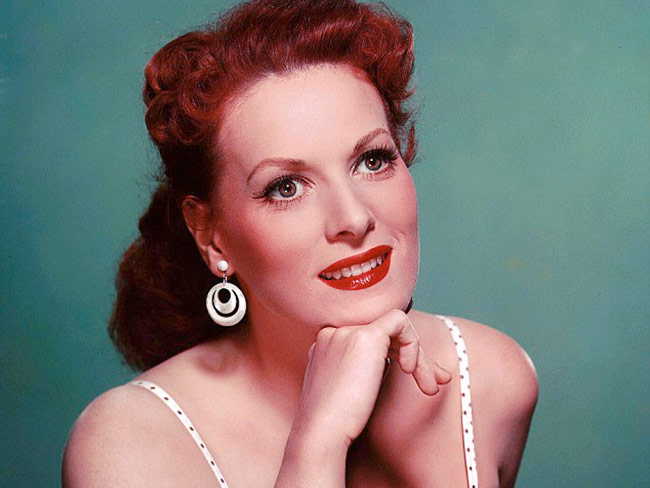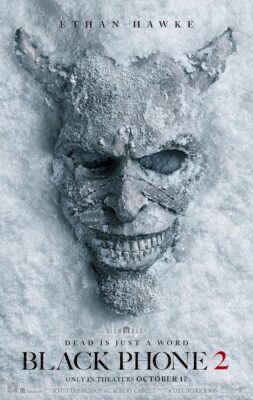They called Maureen O’Hara the Queen of Technicolor because she often starred in color adventure films in the 1940s and ‘50s, tales of pirates with swordplay and such like “The Black Swan” (1942) and “At Sword’s Point” (1952), where she did some fencing herself. With her red hair and blooming complexion, she was Irish through and through, and that went double for her feistiness, both on screen and off.
In the many films that O’Hara made with John Wayne, the Duke looked at her with deep affection and usually offered some variation on the line, “You’re pretty when you’re angry.” O’Hara was best known, finally, as Wayne’s favorite leading lady and the center of many of John Ford’s best films, and to withstand that tough duty she had to be formidable in her own right. This toughness was borne out by the longevity of her life and career and buttressed by her distinctly Irish talent for holding a grudge, which was revealed in her score-settling 2004 memoir “Tis Herself.”
O’Hara was born Maureen FitzSimons in a suburb of Dublin, and she knew early that she wanted to be an actress and received much training from the time she was a little girl. Charles Laughton saw a screen test that O’Hara did as a teenager and he was taken with the spirit and purity of her looks, so that she made her screen debut with him in Alfred Hitchcock’s “Jamaica Inn” (1939) and was the lovely and compassionate Esmeralda to his Quasimodo in “The Hunchback of Notre Dame” that same year.

Laughton brought O’Hara out to Hollywood and sold her contract with him to RKO Pictures, where she starred in Dorothy Arzner’s explicitly feminist “Dance, Girl, Dance” (1940), at one point haranguing a group of rowdy men from a stage for their Male Gaze rudeness. O’Hara was always most effective in scenes like this, scenes where she could reveal the harshly certain, managerial quality underneath the perfect beauty of her face. In Jean Renoir’s “This Land Is Mine” (1943), in which the Nazis are occupying a town she works in, there are several points where O’Hara’s near-awesome strength of purpose and outrage seem like they might make the Nazis quake in their jackboots and flee.
But she had a softer side, too, which John Ford utilized in their first film together, “How Green Was My Valley” (1941), where her wedding veil rises up in the air in a kind of phantom protest as her character marries the wrong man. The implacability of O’Hara made her seem even worthier as a conquest, so that you can understand Tyrone Power’s unfair pursuit of her in “The Black Swan,” which has an unusually dirty script by Ben Hecht that places her in sexual jeopardy at many turns. Her looks and talent could absorb and fortify the sentimentality of a Christmas classic like “Miracle on 34th Street” (1947), but she was far more intriguing in undervalued films like John M. Stahl’s “The Foxes of Harrow” (1947) and Nicholas Ray’s “A Woman’s Secret” (1949), where her rock-solid simplicity was contrasted with the squishy complexity of Gloria Grahame.
O’Hara would still be remembered today for her 1940s work, but it was in John Ford’s “The Quiet Man” (1952) that she really secured her place and standing. As Mary Kate Danaher, O’Hara is filmed in distinctively pearly Technicolor, moving through the mists of Ireland as if she were a kind of sexual dream, a woman worth fighting with and fighting for. When we remember O’Hara today, it should be first and foremost as Mary Kate Danaher, inspiring John Wayne’s Sean Thornton to play “patty fingers” in the holy water at church, goading him and then refusing him on their wedding night when she feels her own integrity and autonomy, the furniture and security of her dowry, has been unfairly taken away from her. O’Hara’s Mary Kate is one of the sexiest and most enticing women in film precisely because she is such an active and unyielding figure, such a tower of strength. She is not easy, in any sense. But if you do battle for her, your reward will be outsized beyond any man’s wildest conjugal fantasies.
O’Hara played a few more times for Ford and also played a rather discreet Lady Godiva on screen in 1955. In the early 1960s, she remained enterprising as the center of Sam Peckinpah’s first film as a director, “The Deadly Companions” (1961) and as the mother in the Disney favorite “The Parent Trap” that same year. O’Hara did battle again with Wayne in the comedy western “McLintock!” (1963), where she was as outraged and pretty as ever during an extended slapstick brawl. There was one more film with Wayne, “Big Jake” (1971), before she retired for twenty years, only returning in 1991 for the charming John Candy comedy “Only the Lonely” and thereafter doing a few carefully selected TV vehicles.
As an older woman, O’Hara remained remarkably unchanged in both looks and manner, and there was something so reassuring about that; as she got into her 90s, she began to decline a bit physically, but she was still as sharp as ever underneath. She was given an honorary Oscar last year, just in the nick of time, and at that ceremony and a recent TCM interview with Robert Osborne, O’Hara was clearly ready to move on to another challenge. She had her Catholic religious faith to bolster her, and that’s what seemed to be most on her mind in these last appearances.
What did Maureen O’Hara mean, as a screen presence and a movie star across many years? She meant strength of purpose, lucky beauty intensified by flinty internal character, and the surety that would never settle for less than her due in the man’s world she inhabited. O’Hara never did reveal what Mary Kate Danaher whispers to Sean Thornton at the end of “The Quiet Man,” taking that secret with her to her grave. But that secret is maybe the password to forever halt or ameliorate the battle of the sexes, and O’Hara’s Mary Kate still holds that up to us as a beacon and a goal.












